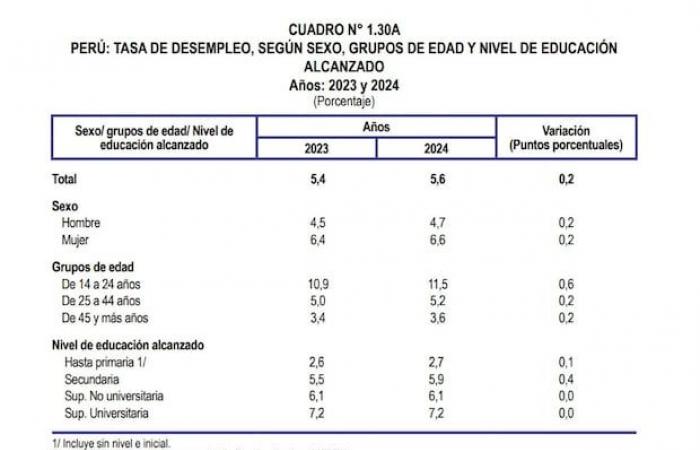According to the IPE, the number of young people who do not study or work – known as “Ninis” – increased by 193 thousand between 2019 and 2023, being 85% of that increase in socio -economic levels D and E. regions such as Cajamarca, Arequipa and Puno report that one in five young people is Nini.
Meanwhile, according to the behavior report of the labor market indicators at the national level and in 27 cities, belonging to the fourth quarter of 2024, reported by the National Institute of Statistics and Informatics (INEI), the unemployment rate of young people from 14 to 24 years stood at 11.5%, in the group of 25 to 44 years in 5.2%and in those of 45 and more years of age at 3.6%.
Also read: unemployment in Peru: more than 1 million without work and the young people were not saved
In The IV Quarter 2024, Unemployment affected young people (10.7%)followed by the group of 25 to 44 years in 4.2% and those of 45 and over 3%.
In conversation with management, Moisés Quiñones, Certus Entrepreneurship Academic CoordinatorHe points out that the disconnection between the education system and the labor market is one of the main factors.
“The economy advances at accelerated rhythms, especially in technology, while education does not always respond to the same step. Many training programs are outdated, which generates an important barefoot”he explains.
Another key problem is the lack of soft skills, highlighting leadership, teamwork and effective communication.
To this is added an unstable economic and political environment, which limits investment opportunities and, therefore, hiring.
“I consider that it has been the mixture of everything: the academic barefoot, the need to resort to better soft skill conditions and especially the social political context we are living. The latter greatly influences the quality and number of investments that reach the country”held.
This other INEI report reveals an increase in the unemployment rate in the youngest, between 2023 and 2024. Photo: INEI.
A phenomenon that is repeated in various sectors is business preference to hire older workers. In 2019, demand for young people surpassed that of adults. Today, that relationship has been drastically invested: formal companies seek four times more workers of 30 years or more, according to the 2025 occupational demand survey.
Why does this happen? For Quiñones, there is a fear of risking with without experience. “Companies feel that hiring someone with experience gives them greater security in terms of productivity. This forces young people to look for other routes, such as entrepreneurship ”, comments.
This situation generates a structural barrier: experience is required to be used, but without employment it is difficult to get it. In fact, 20% of young Lima in 2024 identified their age as an impediment to accessing a job, and on average, four out of ten do not seek employment because there are no positions available for them.
Meanwhile, for the Labor Lawyer Juan Valeramany companies prioritize the hiring of workers with 30 years for more for having the idea that they will have a greater sense of belonging with the work, “because there is thought, I consider wrong, that young people do not have that degree of responsibility with work.”

“You have the wrong thought that young people do not have that degree of responsibility with work,” says Laboralista Juan Valera. Photo: Referential.
Given the lack of opportunities, entrepreneurship appears as an attractive option. And although historically it has been a way out of necessity, today it is emerging as a road with more technical support.
“20 years ago it was unthinkable that there are more than 50 incubators in the country. Today many of them are open to the public. In addition, the Business Development Centers (CDE) are also available, although they do not have enough diffusion”Quiñones details.
Even so, there is a structural problem: two out of three young people do not access higher education, so they are outside the ecosystem of university incubators, which leaves them excluded from vital support to successfully and sustainability.
Another challenge is high informality: more than 50% of new companies in Peru are created as a natural person with business, which limits their projection. However, new figures such as the Simplified Closed Society (SACS), with 100% digital processes and accessible costs, open the door to a more friendly formalization.
For Quiñones, today it is possible to undertake with little capital. Electronic commerce platforms, dropshipping and digital marketing allow you to start businesses without the need for inventory or physical infrastructure. But it emphasizes: what cannot be ignored is knowledge investment.
“Today thanks to technology there are many new business models that can begin with a very low level of investment, but we are talking about investment level in financial issues. What will require this business model, which will compensate and import the investment in knowledge,” he said.
Also read: formal use for the “ninis” (young people who neither study nor work)
Similarly, he indicated that planning, market analysis and differentiation are key for an surviving entrepreneurship.
Current legislation has norms such as Law No. 31828, Law of the young businessman o to Law No. 31979, which promotes temporary employment through state work programs in favor of young people in vulnerability. However, for the Laboring Juan Valerathese efforts have not had the expected impact due to market informality.
“Measures that have not been useful have been implemented, such as the recognition of the time of pre and professionals as work experience. This provision is questionable, since in the practices there are no functions of a worker, and its application has resulted in an unjustified increase in the experience requirements to access formal employment”Valera said in dialogue with management.
From their perspective, policies must focus on encouraging private investment with tax benefits for companies that hire young people, promote training according to market demand and facilitate access to technical education with a practical sense.
It also considers it appropriate to seek to enhance youth employment programs, such as “productive young people” and “young people to work.”

Expert recommends enhancing youth employment programs such as “productive youth” and “young people to work.” Photo: MTPE.
It also proposes to create talent return laws, for young people who emigrate in search of better opportunities and decide to return; Finding regulated labor mobility agreements, encouraging the promotion of innovation ecosystems at the local level and providing security to the general population, amid the delicate context of insecurity that the country is going through, to avoid talent migration.
In a challenging work context and with less dependent employment, digital entrepreneurship has gained ground as a viable alternative to generate income. According to Mariana Pareja del Solar, Seller Development Manager of Free marketin recent months there has been a sustained growth of Peruvian entrepreneurs in items such as technology, fashion and health.
At the moment, More than 5,000 vendors operate monthly on the platform, of which around 15% are new. This phenomenon has been driven by the progress of digitalization and ease of accessing online sales channels. In fact, between January and October of last year there were more than 217 thousand new companies in SUNARP, which represents an 8% growth compared to 2022. E-commerce platforms are positioned as well as a key tool for climbing businesses more quickly and scope.
Also read: Technological sector in Peru: How much more do men earn in front of women?
A concrete example of this impulse is Gamarra, where more than 500 entrepreneurs have recently joined the Mercado Free Platform after receiving advice and training in digital tools. In less than three months, these vendors have loaded more than 7,000 products and registered significant sales.
Among the best -selling articles are low ticket products in categories such as technology (mouse, keyboards, headphones, memories and loaders), fashion (pajamas, babies clothes, basic poles and accessories) and health (supplements, vitamins and medical items). This type of products allows constant rotation and building a solid reputation in the digital environment.








